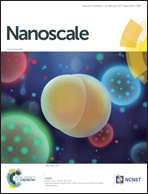Fabrication of directional nanopillars with high-aspect-ratio using a stretching imprint process with a microcavity mold
Abstract
Directional nanopillars with high-aspect-ratio have wide applications in home or industrial appliances and biomimetic robots. Their fabrication, however, is a challenge for conventional methods. In this study, we propose a simple stretching imprint process to prepare controllable directional (30°–90° in a slanted angle) nanopillars (200–800 nm in diameter) with high aspect ratio (>30) using a microcavity mold, beyond the conventional nanoimprint process, for 1 : 1 pattern transfer from the mold to the replica. The mechanism of the stretching imprint process is further investigated, and a rheology model for the filament evolution during the stretching process is established, which clearly shows that the aspect-ratio, diameter in submicrons, slanted angle, and also the tip profile of the free-standing nanopillars can be easily controlled by the imprint process using a microcavity mold. Further experiments indicate that the fabricated directional free-standing nanopillars show strong friction anisotropy, which may find applications in biomimetic studies.


 Please wait while we load your content...
Please wait while we load your content...